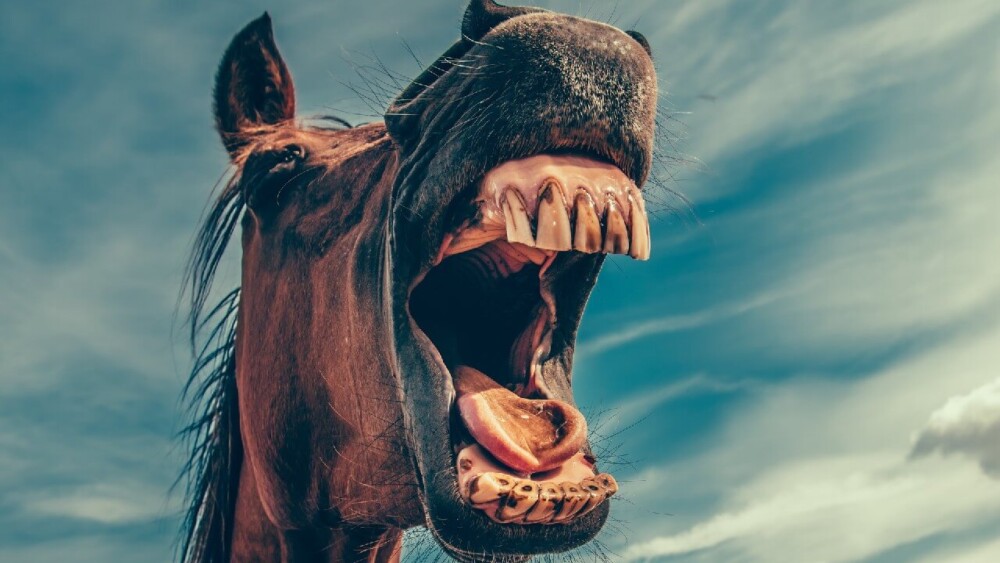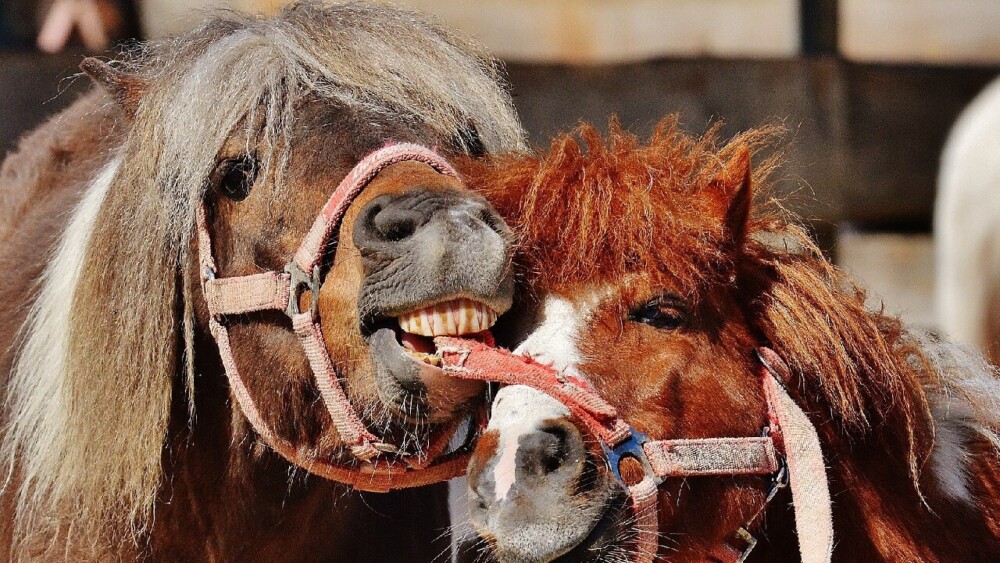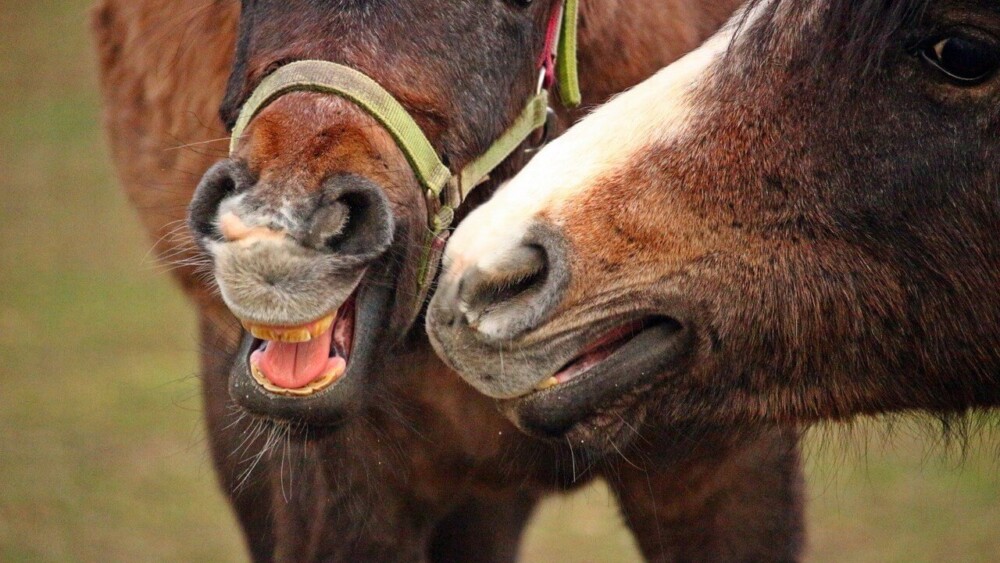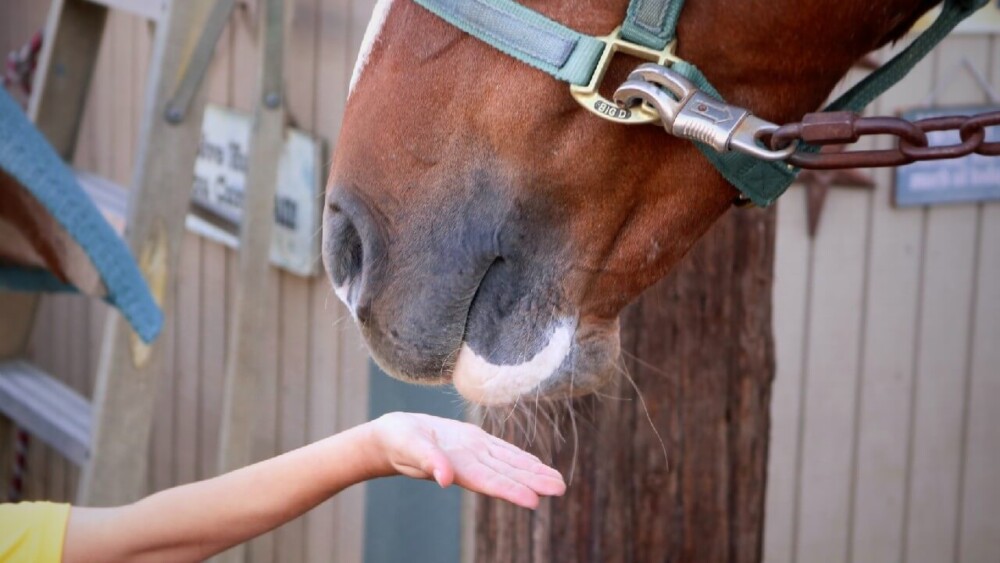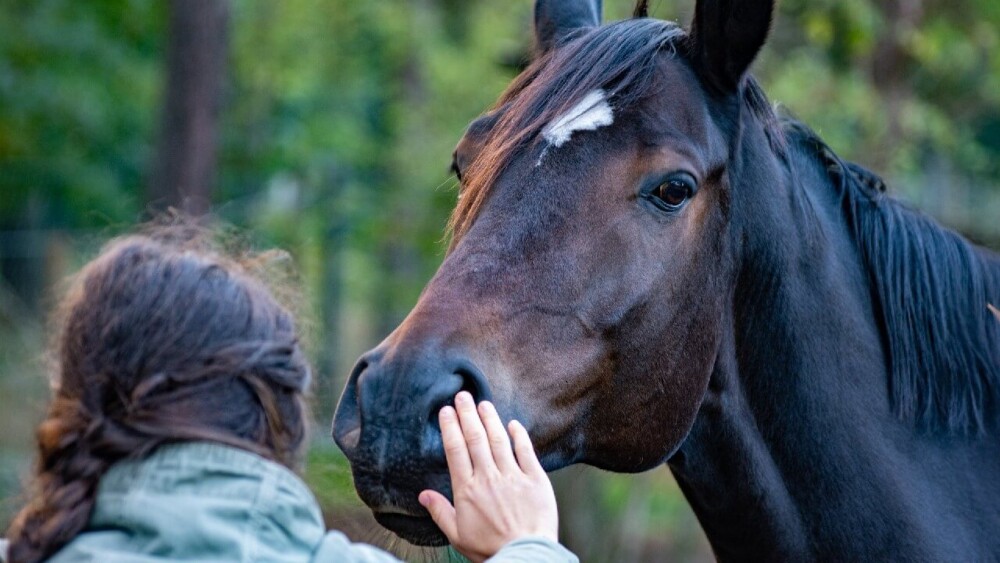In the past, I believed that only bad, abused, and neglected horses bit. After all, I have been around horses for many years. I’m no beginner; I have fixed bucking, rearing, and running away behavior. Even shying and the ninja-style kicking of my gelding proved no issue. But, when I ended up with a biting horse, I wondered “would I be able to fix biting behavior?”
I bought my latest horse, a two-year-old filly (Albion) that I had been eyeing for a while. She was from a good home, had been well socialized, and was essentially a blank canvas. So imagine my surprise when she suddenly began biting me! These weren’t the usual nibbly foal bites either. They were nasty, ears pinned, flat-eyed, ready to take my head off bites.
Why was my new horse biting me? Horses bite because of numerous reasons. These include if they feel unsafe or threatened. A horse may also bite when they are feeling uncomfortable or if they feel stressed. Sometimes, a horse will have developed a food-related biting habit, and hand-feeding can cause biting behavior very quickly. Lastly, a horse that has been touched unkindly or inappropriately will defend themselves with their mouth as this is how they attack in the wild.
The Danger Of a Biting Horse
Most of us think of horses as being docile prey animals. Yet, they are somewhat more like lions in their ferocity. Just watch a really angry horse in the herd, and you will see them in a new light.
When I began riding many years ago, I learned some basics from an experienced endurance rider “Nancy” (name has been changed) who seemed very skittish around horses. Whenever a horse would sniff her or want to nuzzle her, Nancy would freak out and smack them without a second thought. Puzzled, I asked her why she didn’t like her horses being friendly. Nancy told me about a traumatic incident that had left her mentally and physically scarred.
A few years previous, Nancy had been riding her gelding in an open field when a stallion charged them. The stallion attacked Nancy’s horse. Because Nancy was on the gelding’s back, she took the brunt of the attack as the stallion viciously bit her leg.
She suffered severe injuries, spent seven days in the ICU, and lost half of her thigh. She received 153 stitches, and a horrific scar that she would carry for the rest of her life.
Is it dangerous to have a biting horse? Yes, it is dangerous to have a horse that’s a biter. Horses have BIG teeth, and they pack an enormous amount of pressure into a bite. They have the potential to rip away flesh and cause serious injuries. In some cases, a horse bite can even be life-threatening.
What’s worse, horses can bite at the drop of a hat. You may be able to dodge a horse that spins and tries to kick you, but a biter usually catches you off guard.
Understanding Biting Behavior
Before you can prevent biting behavior in your horse, you need to know what can trigger or cause this behavior. In essence, it boils down to your horse not respecting you enough.
My filly, Albion, had become a biter for reasons that weren’t apparent at first, and it was up to me to find out what was causing her to disrespect me enough to bite me.
Sadly, many people’s first reaction is to hit a horse when it bites. This is rarely effective because:
- Horses are much bigger than you.
- They are much stronger than you.
- They will always be faster than you.
- And they will not respect aggressive behavior.
I have always found mares (like Albion) to be a little bit more prone to biting than geldings or stallions, although an aggressive stallion will resort to using his fighting teeth. Horses will start biting for a number of reasons:
1. Fear
Horses will always defend themselves if they feel threatened or afraid. Some horses will cower in the corner of their stable if you enter. Then, they will defend themselves with their back feet. However, if a horse is not the submissive type, then it will attack you as you enter. They may also do this when it’s feeding time as they will be afraid of you taking the food away.
A horse that is low in the pecking order of the herd may attack to defend themself and try to dominate you when it comes to their meals. If the horse has ever been poorly fed and dealt with starvation, they may also be aggressive and fearful around their food. I often see this with horses rescued from a bad situation where they had to compete with other horses for resources such as food, grazing, and water.
2. Aggression
I often find that horses that have been bullied, by herd mates or by humans, tend to defend themselves with aggressive behavior. They will lunge at you, kick out, and barge to get away from you. Most often, these horses aren’t really aggressive at all, and they may only be fearful or uncertain.
Biting can result from their attempts to make themselves feel safe and reassured that they will have enough resources and won’t be further bullied. As you can imagine, hitting a horse that is already aggressively defending themself will only confirm their fears and make them bite more.
3. Pain
Often, horses will bite as a show of pain. It hurts, so they lash out. You will see this with a horse that bites when you tighten the girth if they have saddle sores or ulcers. These horses have no way to say, “ouch, mommy, that hurts,” so they bite instead. Mares often experience increased pain when on their cycle. Sometimes it’s best to give your horse a day off if she’s experiencing pain and you aren’t able to fix it. You don’t want to make it worse.
Even remembered pain can prompt biting. If something used to hurt the horse, they still bite or kick when placed in the same situation, even though it doesn’t hurt anymore. They are acting out of a sense of self-preservation.
4. Dominance
Horses that have been dominated by others may act in a dominant way when they feel insecure or threatened. Dominance displays can include biting. If you are the new owner of a horse, they may try to dominate you as they are unsure of where they fit in. Horses have a herd hierarchy and your horse needs to learn to respect you. Otherwise, this can escalate to biting and kicking behavior.
In a herd, the Alpha horse does not tolerate being bitten. A horse that bites the alpha horse will face expulsion from the herd or serious injury. But, neither of those responses are appropriate for horse owners. Instead, you can teach your horse safely, and without harming him, that it is not ok to bite you.
5. Poor Socializing
Horses need to be taught to respect their owners. Owners may be incredibly intuitive and the best horse owners ever. Or they may be lackadaisical owners that mess up terribly in their keeping and training of their horses. Either way, horses should respect owners. Horses are socialized in the herd dynamic into being respectful of the bigger and wiser horses. Likewise, your horse needs to be socialized into respecting you.
6. Allogrooming
Horses groom each other along the withers and the neck. This social grooming is called allogrooming. It involves biting the neck, withers, shoulders and hips. Allogrooming increases bonding between horses. And, one study found that when humans groom their horses (through scratching), it decreases the horse’s stress levels. But, horses should never allogroom people.
Each interaction with your horse will determine whether they respect you or not. If your horse treats you with disrespect and you ignore it, or even worse, you reward them, then you are setting them up for failure.
Albion: The Biting Filly
So back to the young filly I recently bought. I had been able to work with young Albion for several months when she was just born, so I know I did everything right with her. Hand feeding was kept to a minimum and respectful behavior was reinforced. She stood patiently to lift her feet for cleaning, could be brushed all over, and backed away from the food trough when her feed was given. So where did things go wrong? Why was she now a biting horse?
My answer would appear on the security cameras. I had a sneaky suspicion that something was going on that I wasn’t aware of, so I began to watch footage of when my filly was in her stable. My horses are at a public stable yard where the policy is a firm “Don’t touch other people’s horses.”
Imagine my surprise when I saw that someone was intentionally walking up to Albion, tickling her lips and encouraging her to go into the biting position and then rewarding her with some carrots when she snapped!
This person also allowed her child to walk up to my filly and stick her fingers into Albion’s ears, startling the young filly. I was horrified.
Crazy, right?
This was not a malicious act, but rather one of ignorance. The culprit admitted to not knowing better when confronted, but now I had a problem. My young horse had learned really bad behavior, and she was defending herself from what must have seemed like an unprovoked attack when the child would startle her like that. I pondered how to teach Albion not to bite. It is possible, but takes consistent and hard work.
Stopping Biting Behavior: 7 Steps To Correcting Horse Biting
Now that I knew why Albion was biting, I could find a creative and humane way to teach my filly not to bite. It would mean a complete reschooling of Albion, rebuilding her respect for people, and breaking the behavioral tripwires that she had been conditioned to by other people’s mistakes, which were now setting her off.
Feeding your horse by hand can cause a serious biting problem. Touching their nose, lips, and muzzle can also trigger biting reactions as these are sensitive areas. When a horse willingly touches you with its mouth in a respectful manner, this signals trust. That trust is earned by human and by horse.
I devised a plan of action to teach my filly to stop biting and start being respectful, and this plan will work for most horses that bite too. It uses the elements of distraction, correction, and reward. This is how it works:
1. Improve Feeding Routines
Since food had been the reward for bad behavior, I began to change the way the filly was being fed. I now make sure to reinforce her prior training to back off when I enter the stable with her food, and I refrain from any and all hand feeding. No treats. Even though she is being good, I implemented a three-week ban on treats.
Food is no longer something she associates with anything she did. Her behavior, good or bad, won’t influence how much she is fed or when she is fed. I feed her a good quality diet in the same quantities each day at the same time. It is regular, and it is something she can count on.
Now, Albion neighs at me when she sees me approach with food. I don’t let her dive nose-first into the feed bucket as some owners do. Instead, when I enter her stable, she backs away. I dish up her meal, then leave the stable.
I always make sure Albion has plenty of hay, enough to keep her occupied during the night and comfort her if she needs to chew. I make sure there is enough hay with some leftover the next morning. A full belly helps to stop aggressive behavior.
2. Distract Inappropriate Actions
During the early days of training, there were moments when Albion would pin her ears and lunge at me. I remained cautious and wary around her, watching for the signs that precipitated a biting incident. Albion has a nice tell—a turned head with a typical mare-face to warn me off.
When I see that she is about to bite, I distract her. Without retreating, I lightly tap her with my shoe on the fetlock of the nearest leg or suddenly whistle. A verbal warning proves enough to tell her not to follow through on her biting urge.
Distraction is a powerful tool to break that negative chain of thought that a biting horse gets into. Horses are very skilled at making associations. By distracting her, I am associating the thought of biting me with another part of her body.
I prefer to use my foot to distract her by gently tapping her hoof or I may flick a lead rein over her neck. None of my actions are violent or threatening, so she has no reason to explode. Since she is distracted, she forgets all about biting. Never use force or pain to distract your horse. Be swift to tap your horse’s hoof or flick it’s reins. Speed, not force is the key to success.
3. Replace Unwanted Behavior
Albion usually bit when I began to lock her door at night. That is the physical position she was most in when she was taught the bad behavior or startled by the child’s finger-in-ear actions.
So, I am replacing the unwanted behavior with good behavior. I have established the “back-up” command already, so I ask Albion to step back, then lock the door. Once that is done, I praise Albion, and when she comes closer, I give her one gentle rub down the length of her face, avoiding the mouth area, which reminds her of biting.
4. Correct Slip-Ups
It hadn’t all been moonshine and roses, though. There have been several more biting incidents along the way. Some were serious and others were little more than a little foal mouthiness. When Albion tries to bite me or manages to get her mouth on me, I use verbal reprimands. This is sometimes followed by what I think of as blustering behavior.
Blustering behavior is when I wave my arms or suddenly stamp my feet. In essence, I make myself uncomfortable to be around—moving her out of my space.
I never strike Albion or in any way act violently toward her. If she backs away, I stop, soften my shoulders, lower my hands, and keep my body still. When Albion is good, I allow her closer to me to investigate my presence. She has learned that when she is calm, I am too. If she becomes aggressive, I become busy, and this isn’t nice for Albion to be around.
You can also teach your horse to mimic this behavior. When she respectfully moves out of your space, you have successfully applied the blustering behavior. Striking a horse will make them fear you but not respect you.
5. Build Trust
Since Albion is a young horse, there is a lot of training to still do. She isn’t old enough to back yet and put under saddle, so we work on groundwork and in-hand work. I praise each attempt Albion makes to please me and do the right thing I have asked for. If I ask her to step forward and she does, I praise her. Should she ignore me, I return to tapping or distracting her. I need her focus to be on me.
A horse that is focused on the handler or owner will be respectful. When Albion is ignoring me, it is a sign of disrespect, and I can imagine a bite will follow soon. So I keep her mind busy as well as her body. We play lead games, walk over obstacles, and I build her confidence in me as a good leader. When she sees I won’t hurt her or make her feel uncomfortable or threatened, then she will respect me.
6. Teach Appropriate Touching
Albion had been touched in a way that is actually disrespectful to a horse. Having someone walk up and stick their fingers in your ears or wiggle your lips until you bite is disrespectful. So it was little surprise that she had resorted to biting. She had learned to respond to touch in a violent way, so I had to teach her about appropriate touching.
I begin this with grooming. She was still solid gold with her grooming, so I am extending grooming sessions to kindly touching her all over, stroking her, finding her enjoyment spots to scratch or rub. Albion loves being scratched on her back, and just behind the withers, so this is where I am focusing. When she signals that the touching is making her uncomfortable, I distract her and begin scratching a different spot.
If Albion pins her ears, I signal that I see her with a verbal warning or I spread my arms, making myself appear bigger. She won’t bite what she sees as the bigger “horse.” I allow her to sniff at me, but I watch her. The biting behavior Albion had learned is slowly starting to fade, but it will take time.
7. Reward Respectful Actions
When Albion touches me respectfully by sniffing or backs away when told, I praise and reward with a soothing scratch or a friendly pat on the rump. We are progressing to the point where I will place a treat in her food trough when I am done with a grooming session as a reward.
Albion is not allowed to rush forward and grab it, and I treat this reward the same way I do her normal meals. She has to back away and wait before I rub her face and leave, which is her signal that she can eat.
Successfully Retraining a Biter
The essential elements of retraining a biting horse is more than just following the steps. It also involves your personal awareness and self-restraint. There is a huge temptation to smack a horse that bites you, so it takes a measure of self-restraint to not do that.
When you are retraining a biting horse, you need to practice:
- Awareness to head off any biting behavior before it gets serious
- Restraint
- Calmness
- Thinking like a horse
- Being the wise alpha mare that leads the herd
- Consistency and ALWAYS respond appropriately when a bite is about to happen or happens
- Never ignoring biting
Conclusion
My road with Albion, my biting filly, is not walked yet, and while there has been tremendous improvement, it will take a while before I can fully trust her. With consistent training, I anticipate that Albion will drop her biting behavior within three months. I can already see a huge improvement in her after a month.
Luckily, my main concern is working on her being able to trust and respect me. The rest will follow, and I am confident that biting will be a thing of the past within a few more weeks.
Your biting horse may not have exactly the same situation as my filly does, but you can also apply the same steps. By being consistent and reliable in how you respond, your horse can also learn to trust and respect you. This will discourage biting more than a slap ever will.
Resources
University of Minnesota Extension
My Favorite Equine Resources For Horses and Donkeys
This list contains affiliate products. Affiliate products do not cost more but helps to support BestFarmAnimals and our goal to provide farm animal owners with accurate and helpful information.
Squeaky Chicken Toy is hilarious to watch and the horses love it! It’s not super tough so keep it away from dogs.
Dewormer with Ivermectin: I use this for my horses and my goats. Duvet makes a great dewormer. I switch between the Ivermectin one and one like this one so the worms don’t get immune to it.
Manna Pro Apple Flavored Nuggets are a delicious smelling treat that my horses go crazy over.
Equinity Amino Acid Supplement for Horses makes a big difference for any horse that’s struggling with arthritis, hoof issues, or just generally. It’s great for older horses who can’t absorb all the nutrients in their food as well!
Manna Pro Weight Accelerator helps older horses gain weight and stay healthier! This was especially helpful when one of my older horses lost weight over the winter and helped her regain her weight over the summer!
Farnam Fly Control goes on the horse or donkey and will keep the flies off your sweet pet. It makes horses way more comfortable and will keep sores from getting infected as well.
Wound Kote protects sores and wounds. It acts as an antiseptic and helps wounds heal faster. It works on both my horses and goats.

